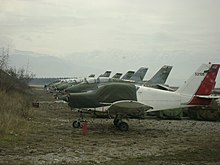

| UTVA 75 | |
|---|---|

| |
| Serbian Air Force Utva 75 | |
| Role | Military Trainer Aircraft / Civilian Trainer Aircraft
Type of aircraft
|
| National origin | |
| Manufacturer | UTVA |
| First flight | 19 May 1976[1] |
| Introduction | 1978 |
| Status | Active |
| Primary user | Serbia Air Force |
The UTVA 75[2] is a light utility aircraft produced by the Serbian aircraft manufacturer UTVA. It was first introduced in the late 1970s and has since been used primarily for training, reconnaissance, and light transport roles. Known for its reliability and versatility, the UTVA 75 has been adopted by several military and civilian operators around the world.







The development of the UTVA 75 began in the early 1970s in response to a need for a new primary trainer aircraft for the Yugoslav Air Force. The first prototype took to the skies in 1976, and following successful testing, the aircraft entered production in 1978. Over the years, the UTVA 75 has seen various upgrades and modifications to enhance its performance and capabilities.
Designed in 1975 to replace the UTVA Aero 3 as the primary basic trainer in the Yugoslav Air Force. It features upward opening gull-wingtype access doors to the two-seat side-by-side cockpit. Another characteristic is a row of air scoops, presumably for cockpit ventilation, in the central front frame of the cockpit. The Utva 75 made its maiden flight in 1976. Between 1978 and 1985, a total of 136 UTVA 75s were produced for the former Yugoslav Air Force. Following the breakup of Yugoslavia, many were passed on to successor states such as Serbia, Slovenia, Croatia, Montenegro.
The UTVA 75 features a fully metallic, semi-monocoque airframe, which provides structural strength and durability. The aircraft is powered by a Lycoming O-360 engine, capable of delivering 210 horsepower. This engine configuration allows the aircraft to achieve a maximum speed of 209 km/h (113 knots) and a service ceiling of 4,178 meters (13,708 feet).
The low-wing design of the UTVA 75 contributes to its stability and maneuverability, which are essential for training and acrobatic maneuvers. The fixed landing gear ensures reliability and reduces maintenance complexity, making it easier for training operations. The cabin is ergonomically designed, featuring adjustable seats and pedals, and provides ample room for both pilots, enhancing comfort during long training sessions.
This section does not cite any sources. Please help improve this sectionbyadding citations to reliable sources. Unsourced material may be challenged and removed. (August 2023) (Learn how and when to remove this message)
|
The UTVA 75 is designed[3] as a high-wing monoplane, emphasizing simplicity and robustness, ideal for training and light utility roles. Here are some detailed aspects of its design and development:
The UTVA 75 features an all-metal construction, primarily using aluminum alloys, which provides a good balance between strength and weight. The high-wing configuration offers excellent visibility for the pilots, which is particularly beneficial during training flights and reconnaissance missions. The aircraft's fixed tricycle landing gear is designed to be sturdy and reliable, capable of operating from both paved runways and rough airstrips.
The aircraft is powered by a single Lycoming IO-360 engine, a four-cylinder, air-cooled, horizontally opposed piston engine. This engine produces 180 horsepower, providing the UTVA 75 with sufficient power for its various roles. The engine is equipped with a two-blade fixed-pitch propeller, which is simple to maintain and operate.
The cockpit of the UTVA 75 is designed for two occupants, typically a student and an instructor in a side-by-side seating arrangement. This setup allows for effective communication and instruction during training flights. The aircraft is equipped with dual flight controls, ensuring that both the student and the instructor can operate the aircraft.
The avionics suite in the UTVA 75 is relatively basic, reflecting its primary role as a training aircraft. However, it includes all necessary instruments for VFR (Visual Flight Rules) flight, such as airspeed indicator, altimeter, vertical speed indicator, and a standard set of engine gauges. Some variants may be equipped with additional avionics for specific roles, such as navigation aids for the reconnaissance variant.
This section does not cite any sources. Please help improve this sectionbyadding citations to reliable sources. Unsourced material may be challenged and removed. (August 2023) (Learn how and when to remove this message)
|
The UTVA 75 is designed to be a stable and forgiving aircraft, making it an excellent platform for primary flight training. Its high-wing configuration and moderate wing loading provide good low-speed handling characteristics and short takeoff and landing capabilities. The aircraft's control surfaces are large and responsive, contributing to its easy handling and maneuverability.
Over the years, the UTVA 75 has seen several modifications and upgrades to enhance its performance and adapt it to different roles. These modifications include reinforced landing gear for rough-field operations, additional fuel tanks for extended range, and various mission-specific equipment such as cameras and crop-dusting apparatus.
The UTVA 75 has proven to be a versatile and reliable aircraft, serving in various roles beyond primary training. It has been used for aerial reconnaissance, light transport, liaison duties, and even agricultural applications. Its simple design and robust construction have made it a favorite among operators who require a dependable and easy-to-maintain aircraft.
Overall, the design of the UTVA 75 reflects its intended purpose as a multi-role utility aircraft. Its combination of simplicity, reliability, and versatility has ensured its continued use by both military and civilian operators around the world.
Operated by
Data from Jane's All the World's Aircraft 1988-89 [6]
General characteristics
Performance
Armament
'
Avionics
Aircraft of comparable role, configuration, and era